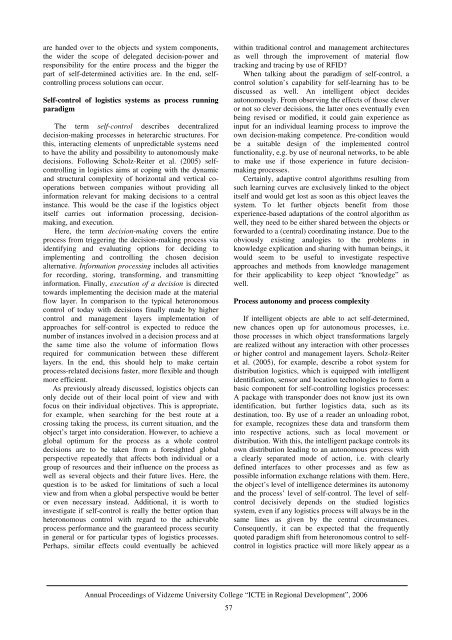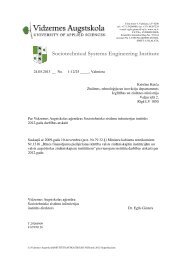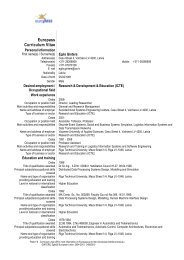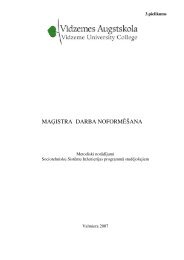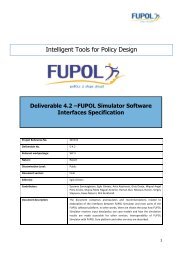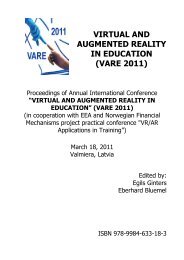methodological consequences <strong>in</strong> logistics, are notforeseeable; some up-to-date research approaches andstill open research questions will be discussed <strong>in</strong> thefollow<strong>in</strong>g section.PROCESS MANAGEMENT AND CONTROLWITH INTELLIGENT LOGISTICS OBJECTSAim of runn<strong>in</strong>g logistics processes is to guide, manageand control logistics processes <strong>in</strong> such way thatperformance targets can be achieved safely, withoutendanger<strong>in</strong>g, quality-conform, efficiently and byeconomical use of resources. For this, logistics processesare discreetly to be adjusted, system-immanent degreesof freedom with the logistics systems are purposefully tobe limited, decision problems are to be solved, conflictsare to be avoided, failures are to be coped with andalternatives are reasonably to be chosen. Activities ofrunn<strong>in</strong>g logistics processes can be related to logisticsprocess control on one hand and logistics processmanagement on the other. Here, logistics process controlcomprises all activities for directly realiz<strong>in</strong>g and<strong>in</strong>fluenc<strong>in</strong>g physical transfer processes <strong>in</strong> logistics atoperational level, whereas logistics process managementis oriented towards their foresighted (strategic), allembrac<strong>in</strong>gdesign and <strong>in</strong>fluenc<strong>in</strong>g.To answer questions on how logistics processes andthe way to run them change with the use of <strong>in</strong>telligentlogistics objects, how process management and controlneed to be designed for <strong>in</strong>telligent logistics objects and –vice versa – which amount of process <strong>in</strong>telligence shouldbe attached to logistics objects <strong>in</strong> certa<strong>in</strong> processes, anumber of aspects is to be discussed which concernprocess structure as well as process procedures.Architectures <strong>in</strong> logistics process management andcontrolIn dependence on the complexity of the logisticsprocesses to be run and on the level of difficulty of thetasks for runn<strong>in</strong>g the process, the control andmanagement functionality is modularly (and thusmanageably) structured <strong>in</strong>to hierarchical layers. Themany and diverse possible concepts vary <strong>in</strong> the targetsystems they should be used for, <strong>in</strong> the depth ofstructur<strong>in</strong>g and <strong>in</strong> the nam<strong>in</strong>g (and tasks) of the differentmanagement and control layers. Despite of the diversityof the architectures the lower control layers always<strong>in</strong>clude process-related control tasks, whereas the uppermanagement layers take over process-distantadm<strong>in</strong>istration and management tasks (see Table 2).Through equipp<strong>in</strong>g logistics objects (and systemcomponents, too) with process <strong>in</strong>telligence they aresupposed to be able to <strong>in</strong>dependently make decisions, actaccord<strong>in</strong>gly and with this to take over particular controltasks. From this, last<strong>in</strong>g impacts are to be expected onthe traditional real-time control of material flows <strong>in</strong>logistics (see Ten Hompel 2005b). In future, it will bepossible to attach process-related control tasks, such asoperational execution of material flow operations by<strong>in</strong>telligent resources (up to now settled on the system orresource layer) and path f<strong>in</strong>d<strong>in</strong>g or resource allocation byTable 2. Layers of process management and control <strong>in</strong> logistics (based upon Kuhn 1995).Normative layerAdm<strong>in</strong>istrative layerDisposition layerNetwork layerSystem or resource layerDescribes general values, norms, targets at strategic levelDeterm<strong>in</strong>es the company’s culture and philosophyDef<strong>in</strong>es requirements on the logistics processesTransfers requirements of the normative layer <strong>in</strong>to target sett<strong>in</strong>gs related to time, costsand qualityCoord<strong>in</strong>ates collaboration of networks <strong>in</strong>clud<strong>in</strong>g their <strong>in</strong>terfacesAdm<strong>in</strong>istrates orders to be processedAllocates resources accord<strong>in</strong>g to demandsCoord<strong>in</strong>ates complex procedures between the different processesAdm<strong>in</strong>istrates correspond<strong>in</strong>g resourcesControls an operation accord<strong>in</strong>g to the <strong>in</strong>put <strong>in</strong><strong>format</strong>ion follow<strong>in</strong>g specific rules<strong>in</strong>telligent objects (up to now settled on the network ordisposition layer), to the (physical) material flow layer.In contrast to this, process-distant management tasksmight not be affected by <strong>in</strong>creas<strong>in</strong>g process <strong>in</strong>telligencewith objects and carriers of the processes.F<strong>in</strong>ally, this could lead to new architectures oflogistics control systems if objects (and systemcomponents) will act <strong>in</strong> the sense of autonomous agentsand future logistics processes will be run by use of multiagent systems. This also might result <strong>in</strong> a strongerdecentralization of the logistics processes and theircontrol up to autarkic sub-processes that aga<strong>in</strong> can bel<strong>in</strong>ked (and to a certa<strong>in</strong> extent centralized) by use of<strong>in</strong>telligent objects. The more and diverse control tasksAnnual <strong>Proceed<strong>in</strong>gs</strong> of Vidzeme University College “ICTE <strong>in</strong> Regional Development”, 200656
are handed over to the objects and system components,the wider the scope of delegated decision-power andresponsibility for the entire process and the bigger thepart of self-determ<strong>in</strong>ed activities are. In the end, selfcontroll<strong>in</strong>gprocess solutions can occur.Self-control of logistics systems as process runn<strong>in</strong>gparadigmThe term self-control describes decentralizeddecision-mak<strong>in</strong>g processes <strong>in</strong> heterarchic structures. Forthis, <strong>in</strong>teract<strong>in</strong>g elements of unpredictable systems needto have the ability and possibility to autonomously makedecisions. Follow<strong>in</strong>g Scholz-Reiter et al. (2005) selfcontroll<strong>in</strong>g<strong>in</strong> logistics aims at cop<strong>in</strong>g with the dynamicand structural complexity of horizontal and vertical cooperationsbetween companies without provid<strong>in</strong>g all<strong>in</strong><strong>format</strong>ion relevant for mak<strong>in</strong>g decisions to a central<strong>in</strong>stance. This would be the case if the logistics objectitself carries out <strong>in</strong><strong>format</strong>ion process<strong>in</strong>g, decisionmak<strong>in</strong>g,and execution.Here, the term decision-mak<strong>in</strong>g covers the entireprocess from trigger<strong>in</strong>g the decision-mak<strong>in</strong>g process viaidentify<strong>in</strong>g and evaluat<strong>in</strong>g options for decid<strong>in</strong>g toimplement<strong>in</strong>g and controll<strong>in</strong>g the chosen decisionalternative. In<strong>format</strong>ion process<strong>in</strong>g <strong>in</strong>cludes all activitiesfor record<strong>in</strong>g, stor<strong>in</strong>g, transform<strong>in</strong>g, and transmitt<strong>in</strong>g<strong>in</strong><strong>format</strong>ion. F<strong>in</strong>ally, execution of a decision is directedtowards implement<strong>in</strong>g the decision made at the materialflow layer. In comparison to the typical heteronomouscontrol of today with decisions f<strong>in</strong>ally made by highercontrol and management layers implementation ofapproaches for self-control is expected to reduce thenumber of <strong>in</strong>stances <strong>in</strong>volved <strong>in</strong> a decision process and atthe same time also the volume of <strong>in</strong><strong>format</strong>ion flowsrequired for communication between these differentlayers. In the end, this should help to make certa<strong>in</strong>process-related decisions faster, more flexible and thoughmore efficient.As previously already discussed, logistics objects canonly decide out of their local po<strong>in</strong>t of view and withfocus on their <strong>in</strong>dividual objectives. This is appropriate,for example, when search<strong>in</strong>g for the best route at across<strong>in</strong>g tak<strong>in</strong>g the process, its current situation, and theobject’s target <strong>in</strong>to consideration. However, to achieve aglobal optimum for the process as a whole controldecisions are to be taken from a foresighted globalperspective repeatedly that affects both <strong>in</strong>dividual or agroup of resources and their <strong>in</strong>fluence on the process aswell as several objects and their future lives. Here, thequestion is to be asked for limitations of such a localview and from when a global perspective would be betteror even necessary <strong>in</strong>stead. Additional, it is worth to<strong>in</strong>vestigate if self-control is really the better option thanheteronomous control with regard to the achievableprocess performance and the guaranteed process security<strong>in</strong> general or for particular types of logistics processes.Perhaps, similar effects could eventually be achievedwith<strong>in</strong> traditional control and management architecturesas well through the improvement of material flowtrack<strong>in</strong>g and trac<strong>in</strong>g by use of RFID?When talk<strong>in</strong>g about the paradigm of self-control, acontrol solution’s capability for self-learn<strong>in</strong>g has to bediscussed as well. An <strong>in</strong>telligent object decidesautonomously. From observ<strong>in</strong>g the effects of those cleveror not so clever decisions, the latter ones eventually evenbe<strong>in</strong>g revised or modified, it could ga<strong>in</strong> experience as<strong>in</strong>put for an <strong>in</strong>dividual learn<strong>in</strong>g process to improve theown decision-mak<strong>in</strong>g competence. Pre-condition wouldbe a suitable design of the implemented controlfunctionality, e.g. by use of neuronal networks, to be ableto make use if those experience <strong>in</strong> future decisionmak<strong>in</strong>gprocesses.Certa<strong>in</strong>ly, adaptive control algorithms result<strong>in</strong>g fromsuch learn<strong>in</strong>g curves are exclusively l<strong>in</strong>ked to the objectitself and would get lost as soon as this object leaves thesystem. To let further objects benefit from thoseexperience-based adaptations of the control algorithm aswell, they need to be either shared between the objects orforwarded to a (central) coord<strong>in</strong>at<strong>in</strong>g <strong>in</strong>stance. Due to theobviously exist<strong>in</strong>g analogies to the problems <strong>in</strong>knowledge explication and shar<strong>in</strong>g with human be<strong>in</strong>gs, itwould seem to be useful to <strong>in</strong>vestigate respectiveapproaches and methods from knowledge managementfor their applicability to keep object “knowledge” aswell.Process autonomy and process complexityIf <strong>in</strong>telligent objects are able to act self-determ<strong>in</strong>ed,new chances open up for autonomous processes, i.e.those processes <strong>in</strong> which object trans<strong>format</strong>ions largelyare realized without any <strong>in</strong>teraction with other processesor higher control and management layers. Scholz-Reiteret al. (2005), for example, describe a robot system fordistribution logistics, which is equipped with <strong>in</strong>telligentidentification, sensor and location technologies to form abasic component for self-controll<strong>in</strong>g logistics processes:A package with transponder does not know just its ownidentification, but further logistics data, such as itsdest<strong>in</strong>ation, too. By use of a reader an unload<strong>in</strong>g robot,for example, recognizes these data and transform them<strong>in</strong>to respective actions, such as local movement ordistribution. With this, the <strong>in</strong>telligent package controls itsown distribution lead<strong>in</strong>g to an autonomous process witha clearly separated mode of action, i.e. with clearlydef<strong>in</strong>ed <strong>in</strong>terfaces to other processes and as few aspossible <strong>in</strong><strong>format</strong>ion exchange relations with them. Here,the object’s level of <strong>in</strong>telligence determ<strong>in</strong>es its autonomyand the process’ level of self-control. The level of selfcontroldecisively depends on the studied logisticssystem, even if any logistics process will always be <strong>in</strong> thesame l<strong>in</strong>es as given by the central circumstances.Consequently, it can be expected that the frequentlyquoted paradigm shift from heteronomous control to selfcontrol<strong>in</strong> logistics practice will more likely appear as aAnnual <strong>Proceed<strong>in</strong>gs</strong> of Vidzeme University College “ICTE <strong>in</strong> Regional Development”, 200657
- Page 1 and 2:
ISBN 9984-633-03-9Annual Proceeding
- Page 3 and 4:
“Development of Creative Human -
- Page 5 and 6:
TABLE OF CONTENTSINTELLIGENT SYSTEM
- Page 7 and 8:
INTELLIGENT SYSTEM FOR LEARNERS’
- Page 9 and 10:
LEARNER 1GROUP OF HUMAN AGENTSLEARN
- Page 11 and 12: QuantityQuantityFigure 6. Distribut
- Page 13 and 14: LEARNERStructure of theconcept mapL
- Page 15 and 16: WEB-BASED INTELLIGENT TUTORING SYST
- Page 17 and 18: materials to be presented and which
- Page 19 and 20: INFORMATION TECHNOLOGIES AND E-LEAR
- Page 21 and 22: correspondence with the course aim
- Page 23 and 24: projects and through IT. Hence, it
- Page 25 and 26: APPLICATION OF MODELING METHODS IN
- Page 27 and 28: can support configuration managemen
- Page 29 and 30: The EKD is one of the Enterprise mo
- Page 31 and 32: CHANGES TO TRAINING AND PERSPECTIVE
- Page 33 and 34: or an end, yet none of these attitu
- Page 35 and 36: make decisions. It cannot be volunt
- Page 37 and 38: logs), data and video conferencing
- Page 39 and 40: Ability to follow user’s multi-ta
- Page 41 and 42: CONCLUSIONSEDUSA method gives us a
- Page 43 and 44: in successful SD. Given this situat
- Page 45 and 46: SPATIAL INFORMATIONFor the visualis
- Page 47 and 48: MOBILE TECHNOLOGIES USE IN SERVICES
- Page 49 and 50: learning environment (Learning Mana
- Page 51 and 52: ago only some curricula on Logistic
- Page 53 and 54: The Web-based version can be access
- Page 55 and 56: Web-portal, which incorporates diff
- Page 57 and 58: DO INTELLIGENT OBJECTS AUTOMATICALL
- Page 59 and 60: Table 1. Examples for introducing R
- Page 61: workable influencing of the process
- Page 65 and 66: • Basic processes, such as wareho
- Page 67 and 68: THE ECR E-COACH: A VIRTUAL COACHING
- Page 69 and 70: participating in the workshops and
- Page 71 and 72: • Assessment modules enable indiv
- Page 73 and 74: with pictures and illustrated graph
- Page 75 and 76: ECR Question Banknumber category su
- Page 77 and 78: educational programme that follows
- Page 79 and 80: DEVELOPMENT OF WEB BASED GRAVITY MO
- Page 81 and 82: These results of a model require a
- Page 83 and 84: CONCLUSIONSThe main goal of work ha
- Page 85 and 86: dimension and included within any o
- Page 87 and 88: • Resources sharing by providing
- Page 89 and 90: Pursuant to the guidelines of elect
- Page 91 and 92: tariffs of regulated services have
- Page 93 and 94: INFORMATION TECHNOLOGY FOR MOTIVATI
- Page 95 and 96: difficult to predict when and for w
- Page 97 and 98: Listeners' workon the WebListenersS
- Page 99 and 100: PERSPECTIVES OF WEB PAGE AND E-MAIL
- Page 101 and 102: INCREASE IN THE NUMBER OF INTERNETU
- Page 103 and 104: tourism accommodations (home pages
- Page 105 and 106: interactive relationships with clie
- Page 107 and 108: • The data obtained by the resear
- Page 109 and 110: Central Statistical Bureau of Latvi
- Page 111 and 112: departures for 1995 are taken from
- Page 113 and 114:
120100maximumworldminimum806040200-
- Page 115 and 116:
140120maximumworldminimum1008060402
- Page 117 and 118:
would be a promising extension. Cur
- Page 119 and 120:
AN OVERVIEW OF THE AGENT − BASED
- Page 121 and 122:
Suitability for social system simul
- Page 123 and 124:
6. MASONDescription:MASON is a fast
- Page 125 and 126:
Suitability for social system simul
- Page 127 and 128:
could be bad particularly when over
- Page 129 and 130:
(for 10 repeat &| CCar[]->runfor);P
- Page 131 and 132:
• Streaming audio• Collaboratio
- Page 133 and 134:
NECESSITY OF NEW LAYERED APPROACH T
- Page 135 and 136:
Up to now, there has only been limi
- Page 137 and 138:
aaaaa6= −aa2,1 = − a0,3226= −
- Page 139 and 140:
∂ u∂x∂ u∂y2 2+ b = 02 2wher
- Page 141 and 142:
a6,3= −2030a4,5−130a4,3- - - -
- Page 143 and 144:
0,10,20,30,4( )Mag x y y Ge wx2, =
- Page 145 and 146:
Example 1. To understand better the
- Page 147 and 148:
Therefore, further the following co
- Page 149 and 150:
SOLUTION OF THE THREE-DIMENSIONALEQ
- Page 151 and 152:
Mag1, m , m , m1 2 3= mm1 m2m32 2 2
- Page 153 and 154:
MagMag0, m , m , m1 2 31, m , m , m
- Page 155:
CONCLUSIONSThe basic content of thi


